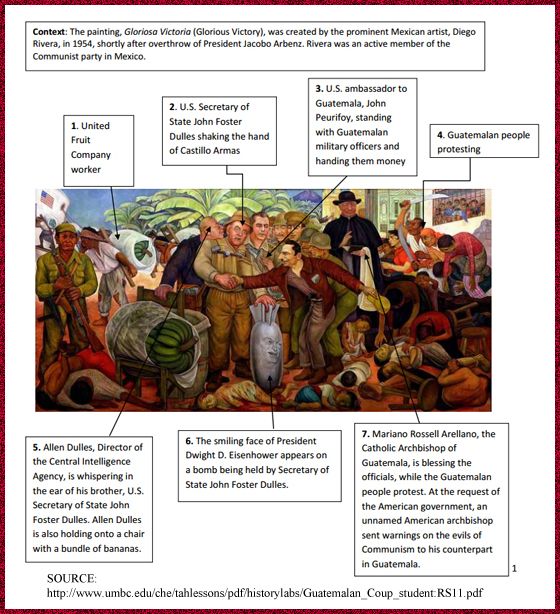Octafish
Octafish's JournalYour post reflects your level of understanding, Dr Hobbitstein, not mine.
Show where I'm wrong in the OP or anywhere on the thread. I'll be happy to apologize.
Bill Clinton, the Lippo Group, and Jackson Stephens of Little Rock, Arkansas (5th Version) 1999
Going by what you write, you probably never heard of Mark Lombardi, a New York artist who created graphic ways of seeing and understanding the connections between the world's high rollers, arch criminals, warmongers, banksters and various states and organizations. Never mentioned by Corporate McPravda and Lackadaemia, we used to talk about him a bit on DU. Here's one of his works, based on social network diagrams and turned into what he called "Narrative Structures."
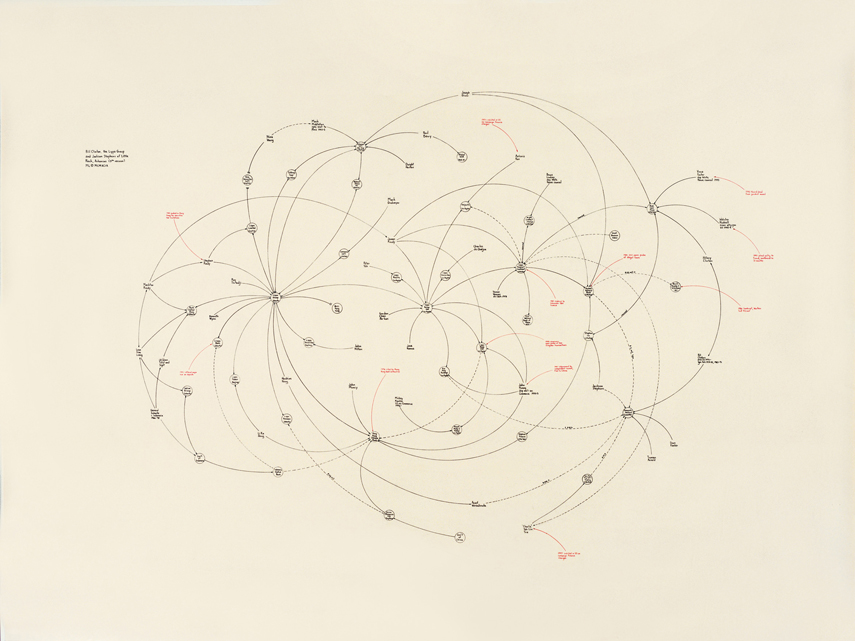
Bill Clinton, the Lippo Group, and Jackson Stephens of Little Rock,Arkansas (5th Version) 1999
Colored pencil and graphite on paper by Mark Lombardi
SOURCE: http://www.pierogi2000.com/2011/03/mark-lombardi-at-pierogi/lombardibillclintonlippo5/
MORE: http://www.flashpointmag.com/mlpic.htm
BACKGROUND: BCCI IN THE UNITED STATES
George W. Bush, Harken Energy and Jackson Stephens c. 1979-90, 5th Version (1999)
For those new to the story: Mark Lombardi chronicled the Bush-Bath-bin Ladin connection in 1999. The next year he was dead, a suicide. After September 11, the FBI showed up at the gallery to photograph his work. Where James R. Bath fits in.
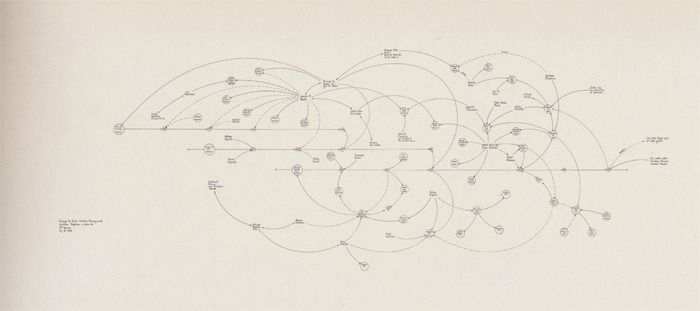
George W. Bush, Harken Energy and Jackson Stephens c. 1979-90, 5th Version (1999)
"Obsessive—Generous"
Toward a Diagram of Mark Lombardi
by Frances Richard
wburg.com
Who is James R. Bath?
A nodal point in Mark Lombardi's drawing George W. Bush, Harken Energy and Jackson Stephens c. 1979-90, 5th Version, 1999, James R. Bath appears in the upper lefthand corner of the 16 1/2" x 41" piece of paper. The spatial syntax of Lombardi's drawings—which map in elegantly visual terms the secret deals and suspect associations of financiers, politicians, corporations, and governments—dictates that the more densely lines ray out from a given node, the more deeply that figure is embroiled in the tale Lombardi tells. Thirteen lines originate with or point to James R. Bath, more than any other name presented. Among those linked to this obscure yet central character are George W. Bush, Jr., George H.W. Bush, Sr., Senator Lloyd Bentsen of Texas, Governor John B. Connally of Texas, Sheik Salim bin Laden of Saudi Arabia, and Sheik Salim's younger brother, Osama bin Laden.
The drawing is done on pale beige paper, in pencil. It follows a time-line, with dates arrayed across three horizontal tiers. These in turn support arcs denoting personal and corporate alliances, the whole comprising a skeletal resume of George W. Bush's career in the oil business. In other words, the drawing, like all Lombardi's work, is a post-Conceptual reinvention of history painting, a document of factually verifiable yet extremely pared-down relationships limned in a double light of international fame and cryptic realpolitik. Or rather, the light is triple. For, though he possessed the instincts of a private eye and the acumen of a systems-analyst, Lombardi was of course an artist, and from the raw material of wire-service reports and books by political correspondents, he drew not only chronicles of covert, high-stakes trade, but technically pristine and sensually compelling visual forms. His project's sources are profoundly art-historical, even as they are obviously journalistic, and the creative tension between abstracted, self-propelling image and direct verbal communication propels his work. Delicately balanced and gracefully enlaced, these lines and circles read from across the room as purely retinal explorations of two-dimensional space. Their stylized complexity, however, lures the eye in, to a point where language registers as legible and referentiality asserts itself through the scrim of form. A narrative emerges. Looking shifts toward reading, and Lombardi's one-two punch lands.
James R. Bath, it turns out, is a Texas businessman, a sometime aeronautics broker whose firm, Skyway Aircraft Leasing, LTD., was a Cayman Islands front amassing money for use by Oliver North in the Iran-Contra affair. Bath also served as an agent minding American interests for a quartet of Saudi Arabian billionaires, one of whom was Sheik Salim bin Laden, the oldest son and heir of Sheik Mohammed bin Laden, father of fifty-four children including Osama. According to reports by the Houston Chronicle, the Wall Street Journal, Time, and others, Bath did business in his own name but with the Saudis' money; tax records indicate that he collected a fee of 5% on their multimillion dollar American investments. In 1979, Bath contributed $50,000 to Arbusto Energy, a limited-partnership controlled by George W. Bush. As Bath had little capital of his own, oil insiders trace the funds to his silent partners, specifically Salim bin Laden. Such cash infusions from Bath's client sheiks and George H.W. Bush's cartel cronies could not, however, prop Arbusto up. The venture collapsed in 1981 and merged into the Spectrum 7 Energy Corporation. Spectrum—still with W. at the helm—evolved through more near-failures and mergers into Harken Energy, which, in 1990, embarked upon a sweetheart deal to drill oil wells in Bahrain—this regardless of the fact that Harken had never drilled an overseas well, nor a marine well of any kind. Oil industry cognoscenti again assume that the Bahrain contract was orchestrated as a favor from the Saudis to the American chief executive and his family. The favor paid. On June 20, 1990, George W. Bush sold two-thirds of his Harken stock at $4 per share. Eight days later, Harken finished the second quarter with losses of $23 million; the stock promptly lost 75% of its value, finishing at just over $1 per share. Two months later, Iraq invaded Kuwait, and the Gulf War began. All these events are cited in Lombardi's drawing.
Meanwhile, another Bath associate, Sheik Khalid bin Mafouz, was involved in the collapse (in July, 1991) of the Bank of Credit and Commerce, International, better known as BCCI. Among the sins of the Pakistani-owned BCCI were money-laundering on behalf of Colombian druglords, arms brokering, bribery, and aid to terrorists; when this cabal came unglued, millions of investors in seventy-three countries lost their life-savings. Although Bath was not personally implicated in the BCCI fiasco, an estranged business partner claims that that he, Bath, had been recruited to the CIA in 1976-77 by George Bush, Sr., after serving in the Texas Air National Guard as the buddy of George Bush, Jr. (in 1972, the two young men narrowly escaped arrest for cocaine possession). Bath's putative CIA connections, the Agency's operations in the Middle East, and the adventures of BCCI thus compose a kind of symmetry. The byzantine saga of BCCI's demise is plotted in the drawing that is perhaps Lombardi's masterwork, BCCI-ICIC-FAB, c. 1972-1991, (4th Version), 1996-2000. Unveiled in the landmark P.S. 1 exhibition "Greater New York" in 2000, this piece signaled Lombardi's arrival at the cusp of art world fame; it is now in the permanent collection of the Whitney Museum. A wall-size panel schematizing twenty years of suspect alliances amongst scores of players, BCCI-ICIC-FAB… was the last major work the artist made before his death.
For those who followed the BCCI scandal—or the Harken Energy/insider trading scandal, or the Banca Nazionale del Lavoro scandal, or the Lincoln Savings & Loan scandal, or any of Lombardi's pet juggernauts—these diagrams summarize rather than amend available knowledge. He was always careful to explain that he did not conduct primary investigations, but culled his information exclusively from the public record; a basic Internet search yields multiple references to the Bath/Bush/bin Laden connection. However, ferreting out and adding up in one's own head the myriad fragments scattered across the infotainment megascape is a very different experience from standing before Lombardi's rhythmic plots. In the strangely contemplative and yet galvanizing presence of these images, the graphic equilibrium with which he invests his subjects is transformative. To track these events in the context of the drawings is to experience their import freshly, to undergo a shock of mixed recognition and surprise.
CONTINUED...
http://www.wburg.com/0202/arts/lombardi.html
A particularly relevant detail:

More detail on the artist and his work:
Mark Lombardi and the Ecstasy of Conspiracy
Michael Bierut
With the 40th anniversary of the assassination of JFK freshly behind us, our abiding romance with conspiracy theories seems more ardent than ever. And one of the most remarkable expressions of that romance is on view at The Drawing Center in New York, "Global Networks," an exhibition of the work of Mark Lombardi. In an age where we all dimly sense that The Truth Is Out There, Lombardi's extraordinary drawings aim to provide all the answers.
Although Lombardi's work has combined the mesmerizing detail of the engineering diagram and the obsessive annotation of the outsider artist, the man was neither scientist nor madman. Armed with a BA in art history, he began as a researcher and archivist in the Houston fine arts community with a passing interest in corporate scandal, financial malfeasance, and the hidden web of connections that seemed to connect, for instance, the Mafia, the Vatican bank, and the 1980's savings and loan debacle. His initial explorations were narrative, but in 1993 he made the discovery that some kinds of information are best expressed diagrammatically.
The resulting body of work must be seen to be believed — an admittedly oxymoronic endorsement of subject matter of such supreme skepticism. Lombardi's delicate tracings, mostly in black pencil with the occasional red accent, cover enormous sheets of paper (many over four feet high and eight feet long), mapping the deliriously Byzantine relationships of, say, Oliver North, Lake Resources of Panama, and the Iran-Contra operation, or Global International Airways and the Indian Springs State Bank of Kansas City. Because the work visualizes connections rather than causality, Lombardi was able to take the same liberties as Harry Beck's 1933 map for the London Underground, freely arranging the players to create gorgeous patterns: swirling spheres, hopscotching arcs, wheels within wheels.
Lombardi was indeed an enthusiastic student of information design, a reader of Edward Tufte and a collector of the charts of Nigel Holmes. But if the goal of information design is to make things clear, Lombardi's drawings, in fact, do the opposite. The hypnotic miasma of names, institutions, corporations and locations that envelop each drawing demonstrates nothing if not the inherent -- the intentional -- unknowability of each of these networks. Like Rube Goldberg devices, their only meaning is their ecstatic complexity; like Hitchcockian McGuffins, understanding them is less important than simply knowing they exist.
Lomardi, who was born in 1951 and died in 2000, did not live to see today's historical moment, where his worldview seems not eccentric but positively prescient. His drawing BCCI-ICIC & FAB, 1972-91 (4th version) was studied in situ at the Whitney Museum by F.B.I. agents in the days after 9/11; reportedly, consultants to the U.S. Department of Homeland Security previewed the current show at the Drawing Center. One wonders whether he would have felt vindicated or alarmed by this kind of attention.
The catalog for the exhibition, which was organized by Robert Hobbs and Independent Curators International, cannot possibly do the drawings justice. But it may be worth it for the extended captions alone, each one of which could serve as an outline for a pretty decent John leCarre novel. And in what other art catalog could you find an index where (under the Cs alone) one finds Canadian Armament and Research Development Establishment; capitalism; Capone, Al; Castro, Fidel, and conceptual art? And it is in the catalog that one finds, tossed away almost casually in a footnote, the following fact: "The police report cited suicide by hanging as the reason for Mark Lombardi's death. The door to his studio was locked from the inside." That last detail is an all-too-common device in mystery novels, where it inevitably raises the same question: yes, that's how it seems, but what really happened? Mark Lombardi's work tries, valiantly, to answer that very question.
11.24.03
http://www.designobserver.com/archives/000072.html
Hope this fills in some blanks for you.
''Our lives begin to end the day we become silent about things that matter.''
The ultimate weakness of violence is that it is a descending spiral,
begetting the very thing it seeks to destroy.
Instead of diminishing evil, it multiplies it.
Through violence you may murder the liar,
but you cannot murder the lie, nor establish the truth.
Through violence you may murder the hater,
but you do not murder hate.
In fact, violence merely increases hate.
So it goes.
Returning violence for violence multiplies violence,
adding deeper darkness to a night already devoid of stars.
Darkness cannot drive out darkness:
only light can do that.
Hate cannot drive out hate: only love can do that.
-- Rev. Martin Luther King, Jr.
Serve one oligarch and you served them all, eh?
That must be why George W Bush and Bill Clinton now work at UBS, with ex-Sen. Phil Gramm who helped repeal Glass-Steagall and stuff, work in the "Wealth Management" department.
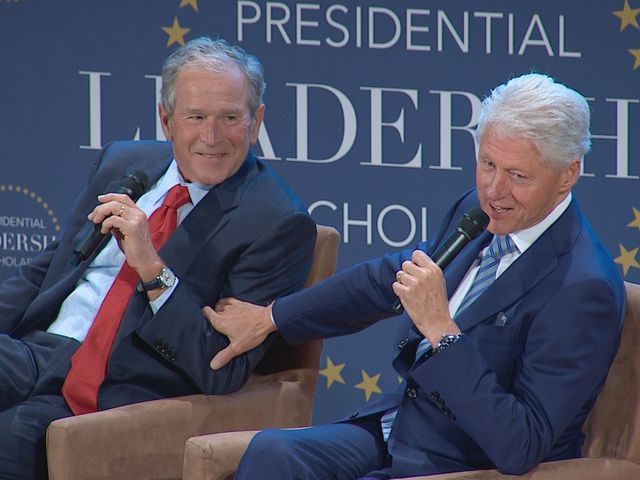
UBS: An amazing story. Do you think they help a lot of poor Democrats become rich ones?
Henry Kissinger, Hillary Clinton’s Tutor in War and Peace
You can tell a lot about a person by seeing who their friends are.
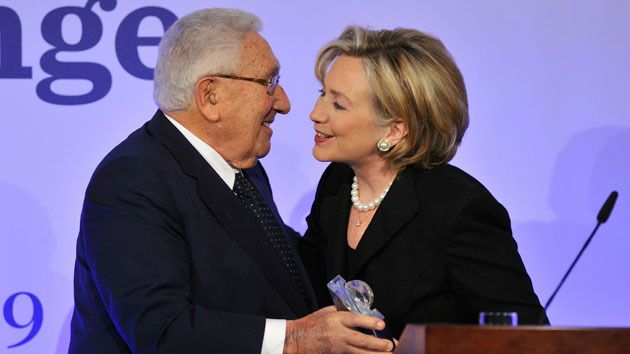
Henry Kissinger, Hillary Clinton’s Tutor in War and Peace
(During debate), Clinton once again praised a man with a lot of blood on his hands.
By Greg Grandin
The Nation, Feb. 5, 2016
Clinton just can’t quit him. Even as she is trying to outflank Bernie on his left, Hillary Clinton can’t help but stutter the name of Henry Kissinger. Last night in the New Hampshire debate, Clinton thought to close her argument that she is the true progressive with this: “I was very flattered when Henry Kissinger said I ran the State Department better than anybody had run it in a long time.”
Let’s consider some of Kissinger’s achievements during his tenure as Richard Nixon’s top foreign policy–maker. He (1) prolonged the Vietnam War for five pointless years; (2) illegally bombed Cambodia and Laos; (3) goaded Nixon to wiretap staffers and journalists; (4) bore responsibility for three genocides in Cambodia, East Timor, and Bangladesh; (5) urged Nixon to go after Daniel Ellsberg for having released the Pentagon Papers, which set off a chain of events that brought down the Nixon White House; (6) pumped up Pakistan’s ISI, and encouraged it to use political Islam to destabilize Afghanistan; (7) began the US’s arms-for-petrodollars dependency with Saudi Arabia and pre-revolutionary Iran; (8) accelerated needless civil wars in southern Africa that, in the name of supporting white supremacy, left millions dead; (9) supported coups and death squads throughout Latin America; and (10) ingratiated himself with the first-generation neocons, such as Dick Cheney and Paul Wolfowitz, who would take American militarism to its next calamitous level. Read all about it in Kissinger’s Shadow!
SNIP...
As first lady, Hillary Clinton spent the early months of her husband’s administration drafting healthcare-reform legislation, only to see it put on the back burner by the North American Free Trade Agreement. Kissinger, in his role as a global consultant, had played a critical role in bringing the various parties who would write that trade treaty together during the previous George H.W. Bush administration. Kissinger continued his NAFTA advocacy with Bill Clinton. As Jeff Faux writes in his excellent The Global Class War, Kissinger was “the perfect tutor” for Clinton, who was “trying to convince Republicans and their business allies that they could count on him to champion Reagan’s vision.”
By September 1993, Hillary’s healthcare bill was ready to be presented to the public and to Congress. But so was NAFTA. All of Kissinger’s allies in the White House, including Mack McLarty, who would soon join Kissinger Associates, pushed Clinton to prioritize NAFTA over healthcare. Clinton did. It was Kissinger who came up with the idea of having past presidents stand behind Clinton as he signed the treaty. Reagan was sick and Nixon still non grata, but “flanked by former presidents Bush, Carter and Ford at a White House ceremony, Mr. Clinton delivers an impassioned speech,” The Wall Street Journal reported. No such presidential backdrop was assembled to help support Hillary Clinton’s healthcare proposal. By August 1994, healthcare was dead.
CONTINUED...
http://www.thenation.com/article/henry-kissinger-hillary-clintons-tutor-in-war-and-peace/
Reading is hard, but it's a good way to learn a lot, fast.
Yay, Oligarchs!
These two make millions off UBS, thanks to Phil Gramm and their work repealing Glass-Steagall and stuff.

UBS! UBS! UBS!

Corporate McPravda
Kissinger helped spawn NAFTA.
Like a friendly bridge between Poppy and Bill.
Henry Kissinger, Hillary Clinton’s Tutor in War and Peace
Last night, Clinton once again praised a man with a lot of blood on his hands.
By Greg Grandin
The Nation,FEBRUARY 5, 2016
EXCERPT...
Then in the early 1990s, Hillary Rodham Clinton would again be caught up in events related to Kissinger’s actions. Her husband, Bill Clinton, embraced Kissinger, which began Kissinger’s apotheosis into his current incarnation as a bipartisan elder statesman, invoked by politicians who want to appear “serious.”
As first lady, Hillary Clinton spent the early months of her husband’s administration drafting healthcare-reform legislation, only to see it put on the back burner by the North American Free Trade Agreement. Kissinger, in his role as a global consultant, had played a critical role in bringing the various parties who would write that trade treaty together during the previous George H.W. Bush administration. Kissinger continued his NAFTA advocacy with Bill Clinton. As Jeff Faux writes in his excellent The Global Class War, Kissinger was “the perfect tutor” for Clinton, who was “trying to convince Republicans and their business allies that they could count on him to champion Reagan’s vision.”
By September 1993, Hillary’s healthcare bill was ready to be presented to the public and to Congress. But so was NAFTA. All of Kissinger’s allies in the White House, including Mack McLarty, who would soon join Kissinger Associates, pushed Clinton to prioritize NAFTA over healthcare. Clinton did. It was Kissinger who came up with the idea of having past presidents stand behind Clinton as he signed the treaty. Reagan was sick and Nixon still non grata, but “flanked by former presidents Bush, Carter and Ford at a White House ceremony, Mr. Clinton delivers an impassioned speech,” The Wall Street Journal reported. No such presidential backdrop was assembled to help support Hillary Clinton’s healthcare proposal. By August 1994, healthcare was dead.
CONTINUED...
http://www.thenation.com/article/henry-kissinger-hillary-clintons-tutor-in-war-and-peace/
Too bad about all those jobs and middle class. Losers. They should stop complaining a get a job.
No. It's a news article. If it were an anti-Clinton OP, I'd have voiced an opinion.
If you want my rational for preferring Bernie Sanders over Hillary Clinton for the Party's nominee, it has to do with Integrity.
Why I hold that opinion.
See UBS.
See Honduras.
See Ukraine.
See Libya.
Those are, of course, based on facts. Taken together they help me form my opinion.
Profile Information
Gender: MaleMember since: 2003 before July 6th
Number of posts: 55,745

